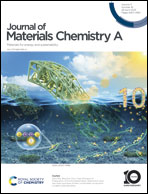Unraveling the device performance differences between bulk-heterojunction and single-component polymer solar cells†
Abstract
The device performance, including efficiency and stability, of polymer solar cells (PSCs) is mainly correlated with the bulk microstructure of specific active layer systems. Generally, developing a single-component (SC) active layer is an effective approach to solving the inherent shortcomings of bulk heterojunctions (BHJs). Herein, we designed and synthesized a conjugated-block copolymer (CBC) PBDB-YTCl-2 and further compared the photovoltaic performance of the CBC PBDB-YTCl-2 and BHJ PBDB-T:PYCl-2 systems. Although both PSC systems show high device efficiencies of over 13%, the contributions of relevant photovoltaic parameters are quite different. We systematically evaluated multiple target parameters, including morphological characteristics, physical kinetics, and active layer stability issues, and compared the correlations and differences between the photovoltaic systems, blend morphology, and device performance of the corresponding CBC and BHJ systems. Our work demonstrates that CBC materials are promising active layer systems, which are conducive to the reduced efficiency-stability gap of PSCs in comparison to the corresponding BHJ all-polymer systems.



 Please wait while we load your content...
Please wait while we load your content...